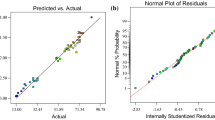Abstract
The presence of pharmaceutical wastewaters containing antibiotic compounds is one of the new problems that need to be addressed in environmental pollution. This study examines ciprofloxacin removal from aqueous solutions through persulfate activated with hybridized ultrasonic waves and synthesized nano zero-valent zinc (NZVZ) particles. NZVZ particles were synthetized by chemical precipitation and stabilized by starch as an eco-friendly stabilizer before application. Modeling and optimization of the process were performed by central composite design (CCD) as a response surface methodology (RSM). The effect of operational parameters, such as initial pH, NZVZ dosage, and persulfate concentration on the removal of the antibiotic have been investigated. The results indicated 55% antibiotic removal observed with initial pH of 4.5, Potassium persulfate (KPS) concentration of 1200 mg/L and NZVZ dosage of 120 mg/L.




Similar content being viewed by others
References
Aboyeji OO (2013) Freshwater pollution in some Nigerian local communities, causes, consequences and probable solutions. Acad J Interdiscip Stud 2(13):111–117. doi:10.5901/ajis.2013.v2n13p111
Anirudhan T, Deepa J (2017) Nano-zinc oxide incorporated graphene oxide/nano cellulose composite for the adsorption and photocatalytic degradation of ciprofloxacin hydrochloride from aqueous solutions. Colloid Interface Sci 490:343–356. doi:10.1016/j.jcis.2016.11.042
Chen W-S, Su Y-C (2012) Removal of dinitrotoluenes in wastewater by sono-activated persulfate. Ultrason Sonochem 19:921–927. doi:10.1016/j.ultsonch.2011.12.012
Dutka M, Ditaranto M, Løvås T (2015) Application of a central composite design for the study of NOx emission performance of a low NOx burner. Energies 8:3606–3627. doi:10.3390/en8053606
Ghodke S, Sonawane S, Gaikawad R, Mohite K (2012) TiO2/nanoclay nanocomposite for phenol degradation in sonophotocatalytic reactor. The Ca Chem Engin 90(5):1153–1159. doi:10.1002/cjce.20630
Giri AS, Golder AK (2014) Ciprofloxacin degradation from aqueous solution by Fenton oxidation: reaction kinetics and degradation mechanisms. RSC Adv 4(13):6738–6745. doi:10.1039/C3RA45709E
Huang C-C, Lo S-L, Lien H-L (2012) Zero-valent copper nanoparticles for effective dechlorination of dichloromethane using sodium borohydride as a reductant. Chem Eng J 203:95–100. doi:10.1016/j.cej.2012.07.002
Kasprzyk-Hordern B, Ziółek M, Nawrocki J (2003) Catalytic ozonation and methods of enhancing molecular ozone reactions in water treatment. Appl Catal Environ 46(4):639–669. doi:10.1016/S0926-3373(03)00326-6
Khan S, Knapp CW, Beattie TK (2016) Antibiotic resistant bacteria found in municipal drinking water. Environ Proc 3(3):541–552. doi:10.1007/s40710-016-0149
Li Y, Li H, Zhang J, Quan G, Lan Y (2014) Efficient degradation of Congo red by sodium persulfate activated with zero-valent zinc. Water Air Soil Pollut 225:2121–2128. doi:10.1007/s11270-014-2121-8
Lin AY-C, Lin C-F, Chiou J-M, Hong PA (2009) O3 and O3/H2O2 treatment of sulfonamide and macrolide antibiotics in wastewater. J Hazard Mater 171(1):452–458. doi:10.1016/j.jhazmat.2009.06.031
Mahamuni NN, Adewuyi YG (2010) Advanced oxidation processes (AOPs) involving ultrasound for waste water treatment: a review with emphasis on cost estimation. Ultrason Sonochem 17:990–1003
Niri MV et al (2015) Removal of natural organic matter (NOM) from an aqueous solution by NaCl and surfactant-modified clinoptilolite. J Water Health 13(2):394–405. doi:10.2166/wh.2014.075
Oh S-Y, Kang S-G, Kim D-W, Chiu PC (2011) Degradation of 2, 4-dinitrotoluene by persulfate activated with iron sulfides. Chem Eng 172(2):641–646. doi:10.1016/j.cej.2011.06.023
Peng H, Pan B, Wu M, Liu Y, Zhang D, Xing B (2012) Adsorption of ofloxacin and norfloxacin on carbon nanotubes: hydrophobicity-and structure-controlled process. J Hazard Mater 233:89–96. doi:10.1016/j.jhazmat.2012.06.058
Pourmoslemi S, Mohammadi A, Kobarfard F, Assi N (2016) Photocatalytic removal of two antibiotic compounds from aqueous solutions using ZnO nanoparticles. Des Wat Treat 57(31):14774–14784. doi:10.1080/19443994.2015.1069215
Rahmani AR, Rezaeivahidian H, Almasi M, Shabanlo A, Almasi H (2016) A comparative study on the removal of phenol from aqueous solutions by electro–Fenton and electro–persulfate processes using iron electrodes. Res Chem Intermed 42(2):1441–1450. doi:10.1007/s11164-015-2095-1
Romero A, Santos A, Vicente F, González C (2010) Diuron abatement using activated persulphate: effect of pH, Fe (II) and oxidant dosage. Chem Eng J 162(1):257–265. doi:10.1016/j.cej.2010.05.044
Saien J, Soleymani A, Sun J (2011) Parametric optimization of individual and hybridized AOPs of Fe 2+/H2O2 and UV/S2O8 2− for rapid dye destruction in aqueous media. Desalination 279:298–305. doi:10.1016/j.desal.2011.06.024
Saien J, Osali M, Soleymani A (2015) UV/persulfate and UV/hydrogen peroxide processes for the treatment of salicylic acid: effect of operating parameters, kinetic, and energy consumption. Desalin Water Treat 56:3087–3095. doi:10.1080/19443994.19442014.19963156
Sayed M, Ismail M, Khan S, Tabassum S, Khan HM (2016) Degradation of ciprofloxacin in water by advanced oxidation process: kinetics study, influencing parameters and degradation pathways. Environ Technol 37(5):590–602. doi:10.1080/09593330.2015.1075597
Smith JE et al (2006) Indirect effects of algae on coral: algae-mediated, microbe-induced coral mortality. Ecol Lett 9(7):835–845. doi:10.1111/j.1461-0248.2006.00937
Soleymani AR, Saien J, Chin S, Le HA, Park E, Jurng J (2015) Modeling and optimization of a sono-assisted photocatalytic water treatment process via central composite design methodology. Process Saf Environ Prot 94(31):307–314. doi:10.1016/j.psep.2014.07.004
Wen G, Wang S-J, Ma J, Huang T-L, Liu Z-Q, Zhao L, Su J-F (2014) Enhanced ozonation degradation of di-n-butyl phthalate by zero-valent zinc in aqueous solution: performance and mechanism. J Hazard Mater 265:69–78. doi:10.1016/j.jhazmat.2013.11.038
Yahya MS, Oturan N, El Kacemi K, El Karbane M, Aravindakumar C, Oturan MA (2014) Oxidative degradation study on antimicrobial agent ciprofloxacin by electro-fenton process: kinetics and oxidation products. Chemosphere 117:447–454. doi:10.1016/j.chemosphere.2014.08.016
Zarei AR, Rezaeivahidian H, Soleymani AR (2015) Investigation on removal of p-nitrophenol using a hybridized photo-thermal activated persulfate process: central composite design modeling. Process Saf Environ Prot 98:109–115. doi:10.1016/j.psep.2015.07.006
Zhang J, Wu Y, Qin C, Liu L, Lan Y (2015) Rapid degradation of aniline in aqueous solution by ozone in the presence of zero-valent zinc. Chemospher 141(31):258–264. doi:10.1016/j.chemospher.2015.07.066
Zou X, Zhou T, Mao J, Wu X (2014) Synergistic degradation of antibiotic sulfadiazine in a heterogeneous ultrasound-enhanced Fe0/persulfate Fenton-like system. Chem Eng 257:36–44. doi:10.1016/j.cej.2014.07.048
Acknowledgments
This research was sponsored by the Research Department of Hamadan University of Medical Sciences. The researchers express their heartfelt gratitude to everyone involved in this study.
Author information
Authors and Affiliations
Corresponding author
Rights and permissions
About this article
Cite this article
Rahmani, A.R., Rezaei-Vahidian, H., Almasi, H. et al. Modeling and Optimization of Ciprofloxacin Degradation by Hybridized Potassium Persulfate / Zero Valent-Zinc/Ultrasonic Process. Environ. Process. 4, 563–572 (2017). https://doi.org/10.1007/s40710-017-0251-x
Received:
Accepted:
Published:
Issue Date:
DOI: https://doi.org/10.1007/s40710-017-0251-x




